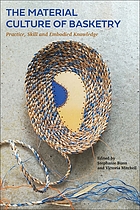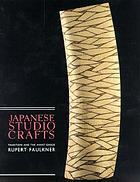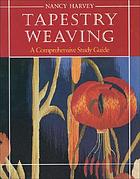Finding Books on Fiber and Textile Arts
On this page you will find a short list of book recommendations about fiber arts, history, and culture.
This is not an exhaustive list, but a place to start. Books are a fantastic resource to learn more about fiber arts and culture, but it can be difficult to pinpoint which books are a worthwhile read or what to read next. It depends on what your interests are, of course. Deciding what your interests are can also be a challenge. Take a look at the texts below for some inspiration!
Reader's advisory resources are tools that can be used by researchers to discover their next read. Your local library or university may have a subscription to tools like NoveList, which can recommend books to you based on your interests and past reads. Goodreads is another example of a reader's advisory source that is free with sign up, and operates similarly to NoveList. These two examples have dedicated categories to the arts and humanities, which can include titles covering fiber arts.
WorldCat is another great resource when looking for books, and other resources as well. WorldCat has entries on thousands of titles, and can direct you to libraries with the items available. If a title is not available at your university library, you may be able to ask a librarian to place an InterLibrary Loan request with a nearby library.
Each cover image has a stable link to the book's WorldCat entry.
African Textiles: Color and Creativity Across a Continent by John Gillow
Written by Joh n Gillow, African Textiles: color and creativity across a continent is a comprehensive and authoritative text concerned with textile variations across the continent, and across cultures. This text provides images of the textiles being discussed, as well as maps highlighting the area from which the technique originated. Fiber arts like carpet and tapestry weaving are included in this text. This text is a strong starting point for students interested in African art.
n Gillow, African Textiles: color and creativity across a continent is a comprehensive and authoritative text concerned with textile variations across the continent, and across cultures. This text provides images of the textiles being discussed, as well as maps highlighting the area from which the technique originated. Fiber arts like carpet and tapestry weaving are included in this text. This text is a strong starting point for students interested in African art.
Navajo Textiles: The Crane Collection at the Denver Museum of Nature and Science by Webster, et al.
Navajo Textiles is an authoritative text based on the Crane Collection housed at the Denver Museum of Nature & Science. This text provides anthropological and historical descriptions for the weavings and rugs included in the collection. Students interested in Indigenous American art may wish to explore this collection through the text, or in-person as well. This text also explains the historical significance of the Indigenous American rug trade during the mid-1800s. The Crane Collection is one of the largest collections of Indigenous American textile arts in the world.
is an authoritative text based on the Crane Collection housed at the Denver Museum of Nature & Science. This text provides anthropological and historical descriptions for the weavings and rugs included in the collection. Students interested in Indigenous American art may wish to explore this collection through the text, or in-person as well. This text also explains the historical significance of the Indigenous American rug trade during the mid-1800s. The Crane Collection is one of the largest collections of Indigenous American textile arts in the world.
The material culture of basketry : practice, skill and embodied knowledge
The Material Culture of Bas ketry by Bloomsburg Visual Arts is an authoritative text on the often underrepresented practice of basketry. This text explores the cultural and historical significance of basketry and basket weaving techniques from traditions across the world. The text explores and argues the sustainable nature of basketry as an art-form, as well as its integrated nature within community. Readers can learn about the making of baskets and its extensive process.
ketry by Bloomsburg Visual Arts is an authoritative text on the often underrepresented practice of basketry. This text explores the cultural and historical significance of basketry and basket weaving techniques from traditions across the world. The text explores and argues the sustainable nature of basketry as an art-form, as well as its integrated nature within community. Readers can learn about the making of baskets and its extensive process.
Japanese studio crafts : tradition and the avant-garde
Japanese s tudio crafts : tradition and the avant garde was authored by Rupert Faulker and published through the University of Pennsylvania Press in 1995. This text can serve as an introduction for readers to the vast, and diverse art styles performed by Japanese artists throughout the 20th century. The covered studio crafts include traditions such as fiberworks, basketry, and textile making. The text covers other traditions as well, outside of the fiber arts subject.
tudio crafts : tradition and the avant garde was authored by Rupert Faulker and published through the University of Pennsylvania Press in 1995. This text can serve as an introduction for readers to the vast, and diverse art styles performed by Japanese artists throughout the 20th century. The covered studio crafts include traditions such as fiberworks, basketry, and textile making. The text covers other traditions as well, outside of the fiber arts subject.
This item is loanable through the SUNY system, and is available at the University at Albany Library.
Tapestry Weaving a Comprehensive Study Guide
Tapestry Weaving by Nancy Ha rvey was published first in 1991, and still serves as a comprehensive text for learning and understanding the art-form. This text presents readers with the information needed to develop basic and intermediate weaving skills. Students interested in weaving as a cultural or historical factor can personally dive into the art-form with this text. Harvey details how to construct a basic loom, and includes multiple patterns throughout the texts. Researchers will learn how to problem solve as they learn their way around a loom.
rvey was published first in 1991, and still serves as a comprehensive text for learning and understanding the art-form. This text presents readers with the information needed to develop basic and intermediate weaving skills. Students interested in weaving as a cultural or historical factor can personally dive into the art-form with this text. Harvey details how to construct a basic loom, and includes multiple patterns throughout the texts. Researchers will learn how to problem solve as they learn their way around a loom.